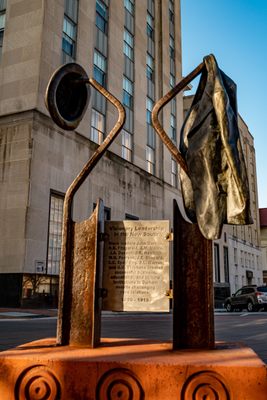About
Located on four blocks of Parrish Street, the area was home to businesses including tailors, barbers, drugstores, and banks. Its success made Durham one of the centers for the Black middle class of the era. Durham activist Paul Scott notes that the area “was known as the ‘mecca of the Black South’ because so much attention was paid to Durham’s economy.” The name “Black Wall Street” came into fashion in the 1950s in recognition of the many financial institutions in the area. The city’s first Black-owned bank, the Mechanics and Farmers Bank (M&F), was designated a National Historic Landmark in 1975.
Black-owned banks were a lifeline for Durham’s Black community. As Travis Rouse, senior vice president and chief sales and lending officer of M&F Bank, told the Duke Chronicle, “M&F extended loans to Black Durham residents when they couldn’t receive financing in white-owned institutions.”
It wasn’t just financial institutions making Black Wall Street a hub. Because of Parrish Street’s proximity to the Hayti District, a Black neighborhood founded in 1865 that lay across the railroad tracks from Black Wall Street, it created an even larger core of Black-owned businesses. Hayti was bounded by Fayetteville, Pettigrew, and Pine Streets, and together, the two areas represented a thriving center of schools and salons, printing companies and grocery stores, hotels and theaters, restaurants and doctors. It meant that Black people would be treated with dignity and respect, free from the oppressions inherent in a Jim Crow-era America.
But despite it being an important part of the city’s heartbeat, it didn’t last. Desegregation, coupled with an urban renewal project that brought the Durham Freeway 147 in the 1970s, meant the end of the area. The highway, the Duke Chronicle notes, “ran directly through and destroyed the neighborhood of Hayti, severed Durham’s central Black business district, disrupting more than 100 Black businesses and displacing hundreds of Black families.” And although the city promised to replace what was lost, it never did. Black Wall Street was effectively dead.
Today the city recognizes both the historical relevance of the area and the importance of preserving its history and stories. Six bronze sculptures now line Parrish Street, “tracing and interpreting its historic significance via three themes: Tobacco and E.J. Parrish (1865-1890), Visionary Leadership in the New South (1890-1915), and A Black Capitol for the World to See (1915-1945).” In 2013, the city erected Black Wall Street Plaza, a small park, at the intersection of Orange, Mangum, and Parrish Streets.
The city also remembers what was lost with the Black Wall Street Gardens project, a public art project that “commemorates and illuminates the importance of Black Wall Street and the legacy of Durham’s African-American business community and features poems by Aya Shabu.” Other businesses, like the Ella West Gallery on Parrish Street, continue the area’s heritage of Black-owned enterprises. The gallery, which opened in 2023, became the state’s only Black female founded fine art gallery and is housed in the building that once held the printing presses for The Durham Reformer, a Black newspaper from the 1920s. As Linda Shropshire, owner of Ella West told Gun & Garden magazine, “I wanted Ella West to anchor the culture of Parrish Street. There’s something beautiful about being a Black-owned business on this street and being able to look back and tell that story.”
Know Before You Go
The district containing the historic Black Wall Street is about four blocks. There are several markers noting the historic sites in the area. In 2013, the city opened Black Wall Street Plaza, a small park at the intersection of Orange, Mangum, and Parrish Streets.
Published
March 1, 2024
Sources
- https://www.wral.com/story/once-thriving-black-wall-street-in-durham-legacy-endures-today/21036175/
- https://www.tclf.org/parrish-street
- https://collections.libraries.indiana.edu/iulibraries/s/land-wealth-liberation/item/23172
- https://socialequity.duke.edu/exhibit/section/remembering-hayti/
- https://www.durhamnc.gov/3912/Black-Wall-Street-Gardens
- https://www.forbes.com/sites/chaddscott/2023/08/10/ella-west-gallery-opens-in-durham-ncs-black-wall-street-with-passion-plan-and-mission/?sh=218a25f370f4
- https://gardenandgun.com/articles/a-dream-realized-at-a-new-art-gallery-in-durham/

















